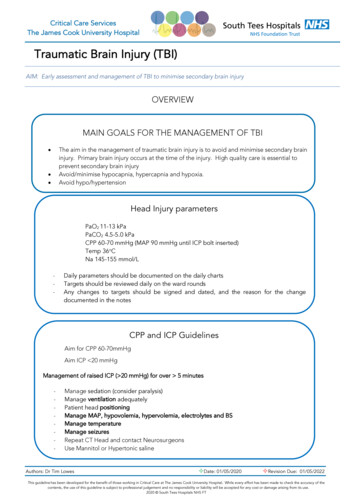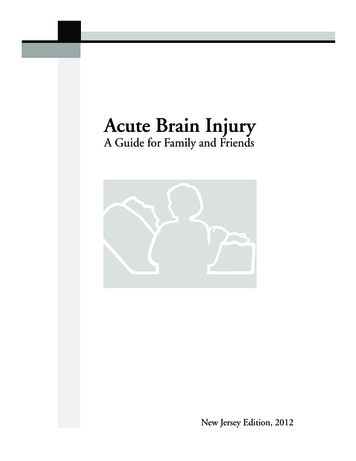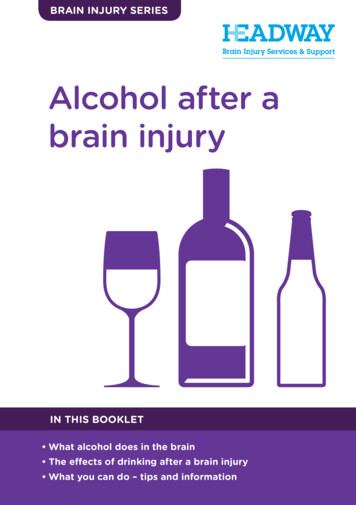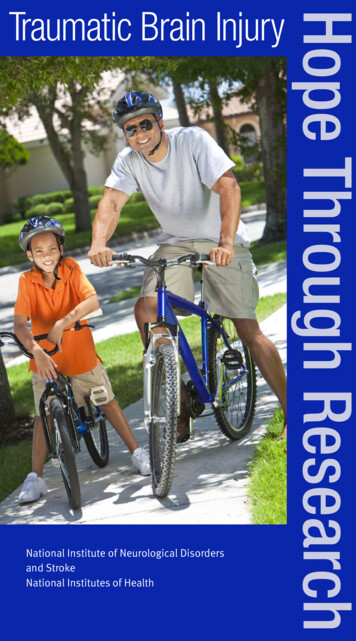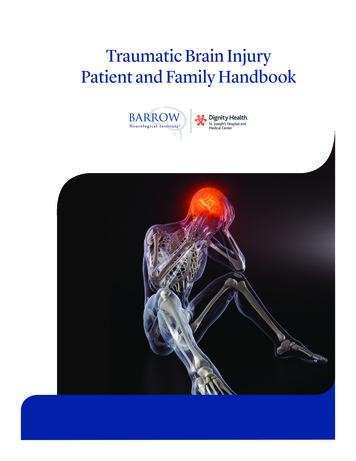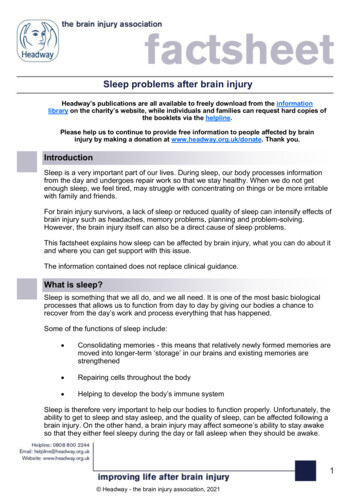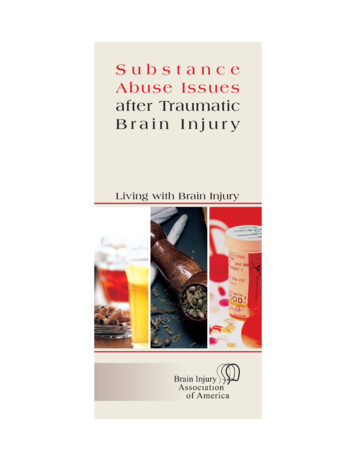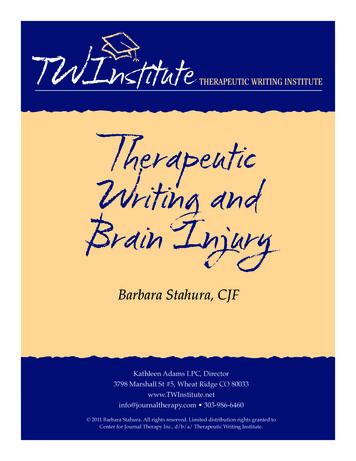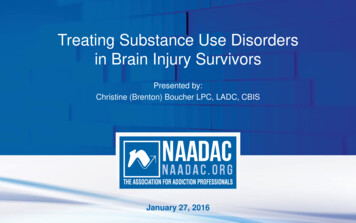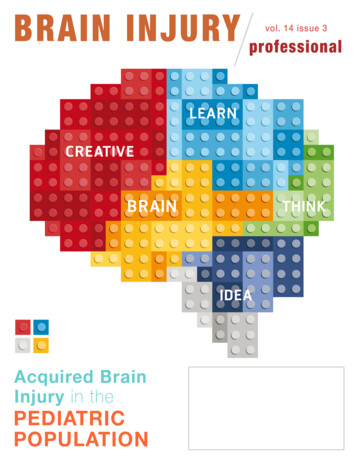
Transcription
BRAIN INJURY professionalvol. 14 issue 3Acquired BrainInjury in thePEDIATRICPOPULATION
Learning Services, Raleigh, North CarolinaBUILDING FUTURES FOR 30 YEARSLearning Services is a national provider of postacute neurorehabilitation services. For threedecades, we have been helping people with braininjuries to navigate the complicated process oftreatment, recovery, and rehabilitation. We operateeight centers of excellence across the country inCalifornia, Colorado, Georgia, Kentucky, NorthCarolina, and Utah. Even as we’ve expanded ourgeographic reach, we have never lost our focus ondelivering individualized rehabilitation.Post-Acute NeurorehabilitationNeurobehavioral RehabilitationSupported LivingDay Treatment RehabilitationFor more information on our programs,please call 888-419-9955or visit LearningServices.com.
BRAIN INJURYprofessionalvol. 14 issue 3CONTENTSEditor in Chief MessageCHAIRMAN Mariusz Ziejewski, PhDVICE CHAIR Debra Braunling-McMorrow, PhDIMMEDIATE PAST CHAIR Ronald C. Savage, EdDTREASURER Bruce H. Stern, Esq.FAMILY LIAISON Skye MacQueenEXECUTIVE DIRECTOR/ADMINISTRATION Margaret J. RobertsEXECUTIVE DIRECTOR/OPERATIONS J. Charles Haynes, JDMARKETING MANAGER Megan Bell-JohnstonGRAPHIC DESIGNER Kristin OdomGuest Editor’s MessageBRAIN INJURY PROFESSIONALdepartments57934Joint Editors MessageBIP Expert Interviewfeatures10Neuroeducational Evaluations - The School-BasedAnswer to Pediatric Neuropsychological AssessmentsNicole Crawford, PhD Heather Hotchkiss, MSW Karen McAvoy, PsyD15Helping Families Navigate the School System to ObtainAppropriate Services after Acquired Brain InjuryPeggy Mazzarella, MA Cynthia Pahr, MSEd, CBISTJanet Tyler, PhD, CBIST1820A Review of Select Programs Addressing the Needs ofEducators, and Students with Brain InjuryThe Value of Educators and Brain Injury EducationSpecialists in a Pediatric Legal CaseBrenda Eagan Brown, MEd, CBIS Sharon Grandinette, MSEd, CBISTCasey Johnson, JD Michael M. Shea, Jr, JD24The Under-identification of Brain Injuries and theRelationship with Juvenile (and Eventually Adult)Criminal Justice InvolvementKim Gorgens, PhD Drew Nagele, PsyD, CBIST Judy Dettmer, PhDStephen Hooper, PhD28NORTH AMERICAN BRAIN INJURY SOCIETYSchool Nurses: Managing Student Concussions andPrivacy ConcernsBrenda Eagan Brown, MEd, CBIS Suzanne Oro, RN, MSN, NCSNKaren McAvoy, PsyDBrain Injury Professional is a membership benefit of the North AmericanBrain Injury Society and the International Brain Injury AssociationPUBLISHER J. Charles Haynes, JDEDITOR IN CHIEF Debra Braunling-McMorrow, PhDEDITOR IN CHIEF Nathan Zasler, MDEDITOR EMERITUS Ronald C. Savage, EdDEDITOR, LEGISLATIVE ISSUES Susan L. VaughnEDITOR, LITERATURE REVIEW Debra Braunling-McMorrow, PhDEDITOR, TECHNOLOGY Tina Trudel, PhDFOUNDING EDITOR Donald G. Stein, PhDDESIGN AND LAYOUT Kristin OdomADVERTISING SALES Megan Bell-JohnstonEDITORIAL ADVISORY BOARDMichael Collins, PhDWalter Harrell, PhDChas Haynes, JDCindy Ivanhoe, MDRonald Savage, EdDElisabeth Sherwin, PhDDonald Stein, PhDSherrod Taylor, Esq.Tina Trudel, PhDRobert Voogt, PhDMariusz Ziejewski, PhDEDITORIAL INQUIRIESManaging EditorBrain Injury ProfessionalPO Box 131401, Houston, TX 77219-1401Tel 713.526.6900Website: www.nabis.orgEmail: mbell@hdipub.comADVERTISING INQUIRIESMegan Bell-JohnstonBrain Injury ProfessionalHDI PublishersPO Box 131401, Houston, TX 77219-1401Tel 713.526.6900Email: mbell@internationalbrain.orgNATIONAL OFFICENorth American Brain Injury SocietyPO Box 1804, Alexandria, VA 22313Tel 703.960.6500 / Fax 703.960.6603Website: www.nabis.orgISSN 2375-5210Brain Injury Professional is a quarterly publication published jointly bythe North American Brain Injury Society and HDI Publishers. 2017 NABIS/HDI Publishers. All rights reserved. No part of thispublication may be reproduced in whole or in part in any way withoutthe written permission from the publisher. For reprint requests, pleasecontact, Managing Editor, Brain Injury Professional, PO Box 131401,Houston, TX 77219-1400, Tel 713.526.6900, Fax 713.526.7787, e-mailmbell@hdipub.com.BRAIN INJURY professional 3
NABIS Ad4 BRAIN INJURY professional
from thepublisherChas Haynes, JDAs those of you who attended the 12th World Congress on Brain Injury earlier this year in New Orleans know, the International Brain Injury Association(IBIA) and the North American Brain Injury Society (NABIS) have formally entered into a strategic partnership through which NABIS will join IBIA as aspecial section.This partnership will allow NABIS and IBIA to deliver significantly enhanced membership benefits to the brain injury professionals that make up bothorganizations. Members of NABIS and IBIA will now have access to a comprehensive set of benefits that combines the strengths of both organizations,providing a more valuable membership experience and the opportunity to be part of a larger and more influential international alliance.What this affiliation means specifically to Brain Injury Professional is that the publication will see a number of editorial and design enhancements, andin addition BIP will become not only the most widely circulated brain injury publication in North America, but also the world.It is with great enthusiasm that we welcome Nathan Zasler, MD, to the editorial leadership of BIP, who will join Debra Braunling-McMorrow, PhD, asco-editor. Dr. Zasler brings decades of experience serving at the helm of some of our field’s leading peer-reviewed publications to BIP, and he will buildupon the outstanding work that Dr. Braunling-McMorrow has done over the last three years. Together, this editorial “dream-team” is working witha new editorial advisory board to develop an exciting four-year editorial calendar with special issues that will address a variety of cutting-edge braininjury topics, including: Advances in Post Traumatic Epilepsy,Sexuality after TBI,Neuro-Optometry,Long-term Community Care,Movement Disorders, andInternational Models to Improve Care.We believe BIP’s unique editorial format, with each issue focusing on a specific topic and guest edited by a recognized leader in that area, make BIPa unique addition to the brain injury literature. In the coming issues, new internationally focused features will be introduced that will make BIP aglobal publication. Some of the more domestic features, such as the non-profit news and the public policy update, will be moved to IBIA’s electronicpublication, the Neuro-Trauma Letter.In addition to the editorial changes, readers will note that this issue has been redesigned in a more accessible and readable format. With boldgraphics and larger tables and figures, we believe this refreshed design compliments the editorial revisions that are already underway and sets BIPapart from all other brain injury publications.As the field of brain injury continues to mature, BIP is likewise evolving to better meet the educational needs of our multidisciplinary readership. Nowmore than ever, it is critical for brain injury professionals to share information on a global level in order to accelerate change. It is our hope that BrainInjury Professional will serve as a platform for communication and exchange for researchers and clinicians working to improve the lives of persons withbrain injury and their families worldwide.Chas Haynes, JDPublisherBRAIN INJURY professional 5
Proven Experience,Exceptional CareTree of Life Services has been helping persons with acquired brain injury optimize theirfunctional outcomes for over 15 years under the leadership of Nathan D. Zasler, MD,internationally recognized brain injury neurorehabilitation physician. We providetransitional rehabilitation and long-term assisted living services in home-like settingsin our community.We strive to optimize client’s functional outcomes by utilizing evidence based medicaland neurorehabilitation assessment and treatment strategies along with close medicaloversight. Our competitive, individualized per diem rates make us a cost effective choicegiven our scope of services , quality of care, and beautiful living environments.Specialized Post-acute Brain Injury Servicestree-of-life.com888-886-5462Call today to make a referral or to schedule a free phone consultation with Dr. Zasler.
from theeditor in chiefAs an Editor in Chief for the Brain Injury Professional, we provide a specialedition on pediatric brain injury as a rotating topic on our editorial calendar.Debra Braunling-McMorrow, PhDFor this edition, Sharon Grandinette, an educator, school reintegration specialist, and expert witness withmore than 26 years of experience serving children and their families, has assembled a range of expertsto address comtemporary areas. Included are overviews of Neuroeducatonal evaluations, the value ofeducators and brain injury specialists in pediatric legal cases, and the value of the school nurse in concussionmanagement. In addition, this edition provides very practical guidance for families navigating the schoolsystem, outlines challenges in issues of consent with descriptive case scenarios, and provides sidebars withuseful resources.I continue to find it remarkable that after almost 10 years of counting persons with brain injury that we continue to undercount and therebyunderserve children with brain injuries. And while it has improved, we still miss counting those most under our watch. The article on the underidentification of juveniles with brain injury in the criminal justice system by Gorgons, Nagele, Dettmer and Hooper brings to mind a well-cited articleand that the Wall Street Journal covered in 2008 by Wayne Gordon and colleagues on the hidden issues of brain injury and the cascade of social illskids may fall into as they become adults challenged to make their way in life.“ As the group of professionals and educators in this edition aim to teach, we need to continueto learn how to better serve our kids.”Thank you Sharon and all the contributing authors in this very special edition.In addition, I want to provide acknowledgment in particular to the states of CA, KS, OR, CO, PA, and NY, as well as George Washington University foreducational support initiatives, and the Brain Injury Association of America for providing Brain Injury specialists training through the Academy of CertifiedBrain Injury Specialists (ACBIS). These states and systems serve as models of best practices for pediatric care and education.On another note, please mark your calendars for the North American Brain Injury Society’s 14th Annual Conference on Brain Injury and 31st AnnualConference on Legal Issues in Brain Injury. The medical and legal conferences will be held simultaneously at the Hyatt Regency Downtown, Houston, TX onMarch 14-17, 2018. Our best wishes go out to the people of Houston and the surrounding communities and those of our staff who live in that area. TheHyatt received no damage during the Hurricane Harvey. NABIS looks forward to supporting the city of Houston.The medical conference will include “An overview of the medical science of brain injury from an outstanding faculty of researchers and clinicianspresenting the very latest in brain injury science, treatment and testing.” For our Legal conference, “Attendees can expect the very latest information onbrain injury litigation at this three-day hands-on conference considered a “must attend” event for all professionals involved in brain injury litigation. Theconference features an all-star cast of top trial attorneys and medical experts who will present a broad array of practical information covering the latestliterature, diagnostic testing methods, rehabilitation, case management, trial techniques and cutting-edge demonstrative evidence. Attorneys will alsobenefit from an overview of the medical science of brain injury”.Due to the success of the Legal Pre-Conference Sessions in 2017 in New Orleans, there will be two legal-specific pre-conference sessions prior to the startof the Annual Legal Conference on Wednesday, March 14, 2018. Additionally, there will be multi-track pre-conference sessions for the medical conferencealso on Wednesday, March 14, 2018.Authors BioDebra Braunling-McMorrow, PhD, is the President and CEO of Learning Services. She serves on the board of the North American Brain Injury Society as ViceChair. She has served as a chair of the American Academy for the Certification of Brain Injury Specialists (AACBIS), board of executive directors of Brain InjuryAssociation of America, and several national committees, editorial boards, and peer review panels. She is a published author and lecturer in the field of braininjury rehabilitation for over 30 years. To contact Dr. McMorrow, please email conference@nabis.org.BRAIN INJURY professional 7
New 3rd Edition!UBIEditiono - ThirdVo l u m e T sr family & frofediuglanan educatioNeurologic RehabilitationThis New Edition features acomprehensive section onNeuropharmacology as well as adetailed section for familyadjustment, tips for caregivers,and commonly asked questionsand answers.A valuable resource forpatients, families, andprofessionals.Print version availiable NOW@ www.FINR.netwww.finr.net800-697-5390To schedule a Continuing Education Inservice, Facility Tour,or to request additional educational materialsplease call Ana Aguilar at 1-800-697-5390 ext. 4420
from theguest editorThis special issue of the Brain Injury Professional is dedicated to acquired braininjuries in the pediatric population, and I am very honored to be the guest editor.Sharon Grandinette, MSEd, CBISTA 13-year skateboarder without a helmet skidded off the sidewalk into on incoming car. a 3 year old slippedthrough the pool fence and nearly drowned . a 7 year old was diagnosed with a brain tumor. a 16 year oldcontracted encephalitis.all of these children acquired a brain injury that impacted functioning. For adults,continued employment after ABI is often at issue, but for children, their job is to be a student. Acquired braininjury (ABI) in children affects educational outcomes and thus, future employment.As a special educator, children have always been close to my heart, and when I began working in pediatric ABI in 1991, not only did I find my passion;I became aware there were few in my field with an understanding of their unique needs. Although I have worked for over 26 years as a pediatricABI educator and school reintegration specialist, and I stand on the shoulders of the pioneers who have come before me, there is still a greatdeal of misinformation regarding assessment, services and outcomes in this population. It is vital that the quest of those pioneers continue, andthat professionals in the field are made aware of children’s distinct needs in order to move toward a better standard of care leading to improvedoutcomes. Although there have been previous editions of the BIP focused on the pediatric population, this issue not only identifies their uniqueprofiles, but also outlines specialized services and programs to address their needs. While not every professional working in ABI include children intheir practice, it is important to keep in mind that “a child with a brain injury grows up to become an adult with brain injury”, and the information canfurther inform treatment as they move into adulthood.In the feature article, Neuroeducational Evaluations - The School-Based Answer to Pediatric Neuropsychological Assessments, Crawford, Hotchkiss,and McAvoy discuss the approach school personnel trained in pediatric brain injury use during assessment, and the differences and similaritiesbetween neuroeducational and neuropsychological evaluations. They outline the unique profile of children with ABI, why it can take time for deficitsto reveal themselves, and share the framework created by the Colorado Department of Education to work effectively with this population.Despite the fact that for years the pediatric literature has provided a clear set of steps regarding how to reintegrate children back to schoolfollowing brain injury, the educational team of Mazzarella, Pahr and Tyler, in their article, Helping Families Navigate the School system to ObtainAppropriate Services After ABI provide detailed information to assist professionals in supporting families through this often confusing journey, andinclude information on training/certification opportunities for educators in pediatric brain injury, as well as a review of model educational programssuccessfully educating these children.In the article, The Value of Educators and Brain Injury Education Specialists in a Pediatric Legal Case, two educators (Eagan-Brown and Grandinette)have paired with two brain injury attorneys (Johnson and Shea) to outline the benefits of deposing students’ pre and post injury educators, list theissues unique to pediatric brain injury that attorneys should be aware of when trying a case, and why adding a brain injury education specialist to theteam of experts can be of benefit.Gorgons, Nagele, Dettmer and Hooper relate the sobering statistics in their article, Under Identification of Brain Injuries, and the Relationship withJuvenile, (and eventually adult) Criminal Justice Involvement. They explore the association between individuals who sustain a TBI in childhood and its’relationship to adult offending behaviors, as well as issues and recommendations regarding the incarceration of juveniles with TBI.When it comes to school aged youth and the skyrocketing number of concussions they sustain, one of the most important school team membersoften over looked is the school nurse. Eagan-Brown, Oro, and McAvoy, in their article School Nurses: Managing Student Concussions and PrivacyConcerns explore the valuable contribution school nurses make facilitating effective medical school communication, and a safe Return to Learn (RTL).In an interview with well known speech pathologist and pediatric BI pioneer Roberta DePompei, Gardner, a school based speech pathologistexplores the important role speech and language pathologists play in identifying the screening and rehabilitation needs of children with ABI, and theeducational impact that cognitive communicative deficits have on school re-entry, performance and social communication.Working with the individuals that contributed to this important edition of the BIP allowed me to collaborate with some of the top professionalsin pediatric ABI across the U.S. They volunteered countless hours to assure the topics selected were written to provide advancement to otherprofessionals in their knowledge regarding how brain injury can impact the pediatric population, and ways in which their unique needs can beaddressed from a variety of professional and clinical perspectives.I hope this issue brings to the reader a deeper appreciation and understanding of how ABI impacts children and adolescents, and ways that willimprove their approach as they work to better their lives and the lives of their families.Authors BioSharon Grandinette, MSEd, CBIST is a nationally and internationally recognized consultant, trainer, advocate and expert witness in the field of specialeducation, with a specialty in pediatric acquired brain injury and school reintegration, and has published in the field. She is an adjunct instructor at theCalifornia State University Dominguez Hills in the graduate Special Education Credential program. Sharon serves on the executive board of NABIS, and servedon the board of the Brain injury Association of CA, where she was chair of the state conference for several years. She was the Executive Director of both theWe Can Pediatric Brain Tumor Network and The California Association of Physical & Health Impairments. Sharon was instrumental in the developing the TBIAdded Authorization that became a part of the special education credential requirements in CA. She owns and operates Exceptional Educational Services inRedondo Beach, CA. www.helpkingkidsbrains.com.BRAIN INJURY professional 9
Neuroeducational Evaluations- The School-Based Answer toPediatric NeuropsychologicalAssessments Nicole Crawford, PhD Heather Hotchkiss, MSW Karen McAvoy, PsyDUnderidentification of Traumatic Brain InjuryIt is estimated that there are currently 145,000 children aged 0-19who are experiencing significant long-lasting social, behavioral,physical and cognitive impacts related to a traumatic brain injury(TBI) (Zaloshnja, Miller, Langlois, et al., 2008). However, the numberof students identified for special education services under the TBIeligibility category in 2014 was 26,000 (U.S. Department of Education,2016). This suggests a gross underidentification of students with TBIfor special education services. There are a number of reasons for thisunderidentification including, but not limited to: information not being shared with the schools, a lack of realization an injury that happened earlier in life couldnow be impacting a student’s learning or behavior in school, a lack of training/understanding on behalf of school personnelabout the causes and impact of the brain injury, and misidentification-some supports may be provided via a formal orinformal plan (e.g., health plan, Multi-tiered System of Support(MTSS), a Section 504 plan, or an Individualized EducationProgram (IEP) under a different special education category thanTBI (e.g., Specific Learning Disability, Emotional Disturbance,Other Health Impaired - ADHD). These categories can be limiting,and the breadth of needs of students with brain injury may not befully identified or addressed.An additional consideration is that while there are many academic,social and behavioral needs shared by students who are found eligiblefor special education across categories such as Specific LearningDisability (SLD), Emotional Disturbance (ED) and Traumatic Brain Injury10 BRAIN INJURY professional(TBI), a student who has sustained a TBI likely has broader needs thana student with a learning disability or emotional/behavioral issues.Students who have sustained a brain injury present a unique profile.One cannot categorize the needs of all students who have sustained abrain injury in one particular way. When an injury happens while thebrain is still developing, which is well into our 20’s, some deficits areobvious right away, while others emerge many years later making itimperative to monitor needs over time. Consequently, it is necessaryto have a specific special education category for TBI to representthe ongoing changes associated with the complex and long-termhealth condition of TBI. In addition, evaluating students and theirneeds requires a multitude of tools - both formal and informal(including observation in the school setting). Traditional standardizedassessments may not be sensitive enough to detect the nuancespresent in the functioning of a student with a brain injury. Becausethere may be gaps in some areas of functioning and unevenness inothers (splinter skills), traditional tools can miss information or provideonly generalized findings that are not discrete or useful.The Role of the School TeamThe Individuals with Disabilities Education Act (IDEA), (34 C.F.R.300.111), states school districts must identify, locate, and evaluateall children with disabilities who need special education and relatedservices. The evaluation must assess the child in all areas related tothe child’s suspected disability. A school-based multidisciplinary teamas well as the parents, make up the IEP team. The IEP team uses theevaluation results to decide the child’s eligibility for special educationand related services and to make decisions about an appropriateeducational program for the child. It is the school’s responsibility to
determine eligibility for special education services, including TBI. Otherinformation (e.g., outside evaluations, hospital/rehabilitation records)is considered by the schools and may be added to the information orbody of evidence, but nonetheless, it is the school’s responsibility toprovide data and determine eligibility within the context of education.Many medical professionals and parents mistakenly believe that whenassessing in the realm of brain injury or other areas of neuropathology,school professionals are not adequately trained to provide suchevaluations. There is a common belief that pediatric neuropsychologistsare best suited for questions related to neurological underpinnings asthey relate to learning, behavior and social skills in schools. Accordingto Miller and Maricle (2014) and Silver, Blackburn, Arffa, et. al (2006),outside clinical pediatric neuropsychological evaluations often assessintellectual ability, academic performance, memory, sensory, motor,visual spatial processing, language, processing speed, attention andexecutive functions. What medical professionals and parents maynot understand is that properly trained and empowered schoolbased multidisciplinary teams, which include teachers, occupationaltherapists, physical therapists, speech language therapists, schoolpsychologists, social workers, school nurses, vision and hearingspecialists, etc., can also provide assessments in intellectual ability,academic performance, memory, sensory, motor, visual spatialprocessing, language, processing speed, attention and executivefunctions. Additionally, school-based professionals have a uniqueknowledge of the school setting as well as expertise in special educationlaw and eligibility. Moreover, the members of the multidisciplinaryteam also have daily observation, and exquisite understanding ofhow these cognitive areas are “functionally” manifested in the schoolsetting and effect learning and behavior. The school professionals usethe results of the school-based assessment to identify interventions,accommodations, and supports that are the best fit for that particularstudent and environment.There are many undeniable positives to school-based multidisciplinaryteams assessing students with brain injury or other neurocognitivedisorders, which include: School-based multi-disciplinary team assessments are availableto all students at no cost. Unfortunately, there is frequently ashortage of clinical pediatric neuropsychologists and wait times foran outside neuropsychological assessment can be from six monthsto over a year. Additionally, a neuropsychological evaluation isoften cost-prohibitive for many families. Student data collected in the school setting is relevant to currentfunctioning and aligned with educational or behavioral areas ofconcern. Diagnoses from the Diagnostic and Statistical Manual ofMental Disorders (DSM) or information from a neuropsychologicalreport may have limited utility if it overemphasizes medicalterminology (Miller and Maricle, 2014) or may not directlytranslate into meeting the eligibility requirements of specialeducation or even the need for special education services (Miller,2013). Functional educational impact and the need for specialeducation services must be assessed by the school-based multidisciplinary team. An outside neuropsychological evaluationcannot stand alone as a comprehensive special educationevaluation. Parents are an essential part of the team and a long-termpartnership is created. Many times, students spend much of theirgrade school careers in one school system, and a partnershipbetween the parents and the school-based team is advantageous.If an outside neuropsychologist recommends that a child “beplaced in a special education program” but the child does notactually qualify for special education services (due to the factthat special education eligibility is governed by complex federalregulations, not simply by the presence of objective data), itcreates a situation that can be confusing and frustrating forparents and can lead to acrimony. School-based special education evaluations are well-rounded andconsider the whole child by gathering multiple pieces of formaland informal data, including formal cognitive and academicassessments, observations in multiple school settings and socialsituations, teacher, parent and student interviews/reports,response to intervention data and a history of performanceand behavioral data. Classroom observations, peer interactions,and student response to school-based stimuli are all importantaspects of understanding the student’s abilities and their deftnessfor learning and behaving. Outside neuropsychological reportsfrequently incorporate limited school data, and when included,it is commonly general perceptions provided by the parentsor statewide standardized test scores which may not providean accurate reflection of how the child is performing in theschool setting or as compared to their same aged peers. Whena neuropsychologist is available and working with the family,communication is essential. The sharing of data about schoolperformance, learning, behavior and a reflection of how the childis performing in the school setting compared to same aged peers isnecessary for an accurate reflection of a child’s functioning acrossenvironments. The school-based multidisciplinary team typically has uniqueand valuable information about, and experiences with, the childthat is essential to the special education evaluation in relationto the child’s cognitive, academic, emotional and behavioralstrengths and weaknesses. Personal and long term knowledge ofthe child, his/her abilities and the history of academic records areall valuable sources of pre- and post- functioning performancefor a student with a brain injury. The outside neuropsychologist,however, may only have short-term contextual knowledge of thechild within the assessment setting (Fletcher-Janzen, 2005). The school-based multidisciplinary teams and many schoolpsychologists are trained in and able to robustly assess thefunctional impact of cognitive deficits in the school setting and arein possession of relevant, day-to-day, information about how thedeficits impact the student’s ability to function in the academicsetting. Scho
Brain Injury Professional is a membership benefit of the North American Brain Injury Society and the International Brain Injury Association 5 . and the value of the school nurse in concussion . conference features an all-star cast of top trial attorneys and medical experts who will present a broad array of practical information covering the .

